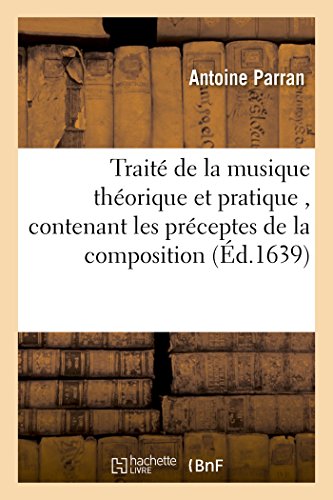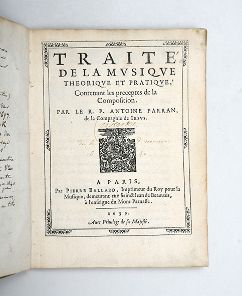parran antoine (2 résultats)
Type d'article
- Tous les types d'articles
- Livres (2)
- Magazines & Périodiques
- Bandes dessinées
- Partitions de musique
- Art, Affiches et Gravures
- Photographies
- Cartes
-
Manuscrits &
Papiers anciens
Etat
Reliure
- Toutes
- Couverture rigide
- Couverture souple (1)
Particularités
- Edition originale (1)
- Signé
- Jaquette
- Avec images (1)
- Sans impression à la demande
Pays
Evaluation du vendeur
-
Traité de la Musique Théorique Et Pratique, Contenant Les Préceptes de la Composition (Sciences Sociales) (French Edition)
Edité par Hachette Livre Bnf, 2016
ISBN 10 : 2019538768ISBN 13 : 9782019538767
Vendeur : Lucky's Textbooks, Dallas, TX, Etats-Unis
Livre
Etat : New.
-
Traité de la musique theorique et pratique, contenant les preceptes de la composition.
Edité par Paris: Pièrre Ballard, 1639, 1639
Vendeur : Peter Harrington. ABA/ ILAB., London, Royaume-Uni
Edition originale
First edition of the French Jesuit's work on music, a superb association copy, inscribed by Constantijn Huygens with his Latin motto 'Constanter' and recording this as being a gift from the eminent French philosopher and scientist Marin Mersenne, who corrected the work and corresponded with the author. Mersenne (1588-1648) was central to French scientific life in the period, establishing a community of scholars and scientists based around his monastic order of Minims at Paris, and corresponding with leading intellectuals across Europe, including Gassendi, Descartes, van Helmont, Fermat, Hobbes, and Pascal. He founded the Academia Parisiensis in 1635, the precursor to the Académie des sciences established by Colbert in 1666. Constantijn Huygens (1596-1687) was born into a wealthy family serving the house of Orange, and with "a strong educational and cultural tradition. The grandfather took an active part in the education of his children, and thus [Constantijn] acquired great erudition in both literature and the sciences. He corresponded with Mersenne and Descartes, the latter often enjoying his hospitality in The Hague. Constantijn was a man of taste in the fine arts, talented in drawing, a musician and fertile composer, and, above all, a great poet; his Dutch and Latin verse gained him a lasting place in the history of Dutch literature" (DSB). The author of the treatise, Antoine Parran (1587-1650), corresponded with Mersenne on musical theory. In a letter in the archives of the Bibliothèque Nationale, Paris, Parran thanks Mersenne for reading and correcting the Traité (see De Waard, Correspondence du P. Marin Mersenne, pp. 728-729). Another letter, by the composer Jan-Albert Ban (1597 1644), reveals he was asked by Huygens to forward Parran's work, this copy, to Mersenne (De Waard, ibid, p. 405). The volume, linking the author with his reviser to an important literary figure through a composer, is an excellent example of intellectual exchange in the early modern era. Mersenne held Parran in high regard, and praised him in his Cogitata phyisco mathematica (1644). Huygens did not think as highly of Parran, telling Ban that he did not think Parran's book had made him any more informed, although it would undoubtedly make him more skilled in replying to French opinions (Correspondence, 450-1). Ban had been introduced to Mersenne by Huygens and the presentation of Parran's Traité may have taken place in the context of Ban's disagreements with Mersenne and other French music theorists at this time (see D. P. Walker, 'Mersenne's musical compeition of 1640', in Studies in Musical Science in the Late Renaissance, 1978). The concept of music in the seventeenth century was closely linked to philosophy and mathematics, with the idea proper music signified balance in things or ideas. The Traité itself is chiefly devoted to the exposition of the rules of musical composition, mainly using examples taken from the music of Eustache du Caurroy and Claude Le Jeune. It contains digressions on the history of music, unusual for a work of this time, and deals with the social function of music. A second edition followed in 1646. Quarto (229 x 174 mm). Contemporary vellum, manuscript label to spine. Housed in brown cloth solander box. Woodcut device on title, and one folding table. Bookplate of French musicologist Henry Prunièrs (1886-1942) to front pastedown. Title page inscribed "Constanter" and "don de P. Mersenne 1640" (see note); verso of front free endpaper with early notes concerning the provenance in Dutch and French. A very few leaves damp-stained at upper corners; an excellent, crisp copy.



